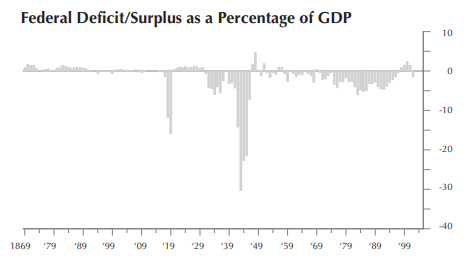Much ado has been made of the return of the Federal deficit, mostly by those who deride tax cuts. Frequently heard is the argument that deficits represent an increase in demand for credit that in turn will increase interest rates, to the detriment of economic growth. While this argument is unsubstantiated, the outlook for long-term government spending is worrisome.
Interest rates have recently dropped to their lowest level in over 40 years, despite a return to deficit spending. There is scant empirical evidence that deficits and interest rates are correlated. In our view, interest rates are driven by the inflationary expectations of investors. Moreover, the Federal deficit by historical standards is modest in proportion to economic activity as measured by Gross Domestic Product (GDP). Currently the spread between conventional and inflation-protected Treasury securities suggests that the market is relatively unconcerned about future price inflation (see January 2003 INVESTMENT GUIDE).
However, should deficits outpace economic growth for a sustained period, the outlook would indeed be bleak. If history is any guide, the government would at some point revert to the printing press to finance its debt, and inflationary expectations would again be revived. But deficits aside, the level of spending is arguably a more important consideration; government spending hampers growth by diverting resources that would otherwise be employed more effectively in the private sector.
The Federal surplus/deficit is notoriously unpredictable. However, Congress’s appetite for domestic spending is undiminished, and the war in Iraq is projected to cost roughly $90 billion. We favor a reduction in taxes on income and capital that would serve to boost economic growth and tax revenues, but we won’t hold our breath. Investors’ best course of action is to hold inflation-resistant assets, including gold and common stocks, and to keep their fixed-income investments short-term.

Also in This Issue:
The Time Tested Dow
Random Walk to Retirement
Barrick Gold
The High-Yield Dow Investment Strategy
Recent Market Statistics
The Dow-Jones Industrials Ranked by Yield
To access the full article, please login or subscribe below.
Already a Subscriber?
Log in now
Subscribe Today
Get full access to the Investment Guide Monthly.
Print + Digital Subscription – $59/YearIncludes 12 Print and Digital Issues
Print + Digital Subscription – $108/2 Years
Includes 24 Print and Digital Issues
Digital Subscription – $49/Year
Includes 12 Issues
Digital Subscription – $98/2 Years
Includes 24 Issues

